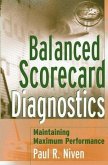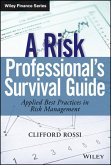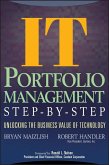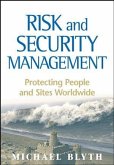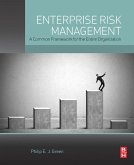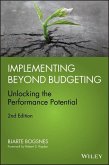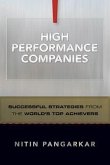Gregory Monahan
Enterprise Risk Management (eBook, ePUB)
A Methodology for Achieving Strategic Objectives
51,99 €
51,99 €
inkl. MwSt.
Sofort per Download lieferbar

0 °P sammeln
51,99 €
Als Download kaufen

51,99 €
inkl. MwSt.
Sofort per Download lieferbar

0 °P sammeln
Jetzt verschenken
Alle Infos zum eBook verschenken
51,99 €
inkl. MwSt.
Sofort per Download lieferbar
Alle Infos zum eBook verschenken

0 °P sammeln
Gregory Monahan
Enterprise Risk Management (eBook, ePUB)
A Methodology for Achieving Strategic Objectives
- Format: ePub
- Merkliste
- Auf die Merkliste
- Bewerten Bewerten
- Teilen
- Produkt teilen
- Produkterinnerung
- Produkterinnerung

Bitte loggen Sie sich zunächst in Ihr Kundenkonto ein oder registrieren Sie sich bei
bücher.de, um das eBook-Abo tolino select nutzen zu können.
Hier können Sie sich einloggen
Hier können Sie sich einloggen
Sie sind bereits eingeloggt. Klicken Sie auf 2. tolino select Abo, um fortzufahren.

Bitte loggen Sie sich zunächst in Ihr Kundenkonto ein oder registrieren Sie sich bei bücher.de, um das eBook-Abo tolino select nutzen zu können.
Written for enterprise risk management (ERM) practitioners who recognize ERM?s value to their organization, Enterprise Risk Management: A Methodology for Achieving Strategic Objectives thoroughly examines operational risk management and allows you to leverage ERM methodology in your organization by putting author and ERM authority Gregory Monahan's Strategic Objectives At Risk (SOAR) methodology to work. A must-read for anyone interested in risk management as a strategic, value-adding tool, this no-nonsense book shows you how to use ERM and SOAR to empower your company to go from stuck to competitive.…mehr
- Geräte: eReader
- ohne Kopierschutz
- eBook Hilfe
Andere Kunden interessierten sich auch für
![Balanced Scorecard Diagnostics (eBook, ePUB) Balanced Scorecard Diagnostics (eBook, ePUB)]() Paul R. NivenBalanced Scorecard Diagnostics (eBook, ePUB)32,99 €
Paul R. NivenBalanced Scorecard Diagnostics (eBook, ePUB)32,99 €![A Risk Professional s Survival Guide (eBook, ePUB) A Risk Professional s Survival Guide (eBook, ePUB)]() Clifford RossiA Risk Professional s Survival Guide (eBook, ePUB)76,99 €
Clifford RossiA Risk Professional s Survival Guide (eBook, ePUB)76,99 €![IT (Information Technology) Portfolio Management Step-by-Step (eBook, ePUB) IT (Information Technology) Portfolio Management Step-by-Step (eBook, ePUB)]() Bryan MaizlishIT (Information Technology) Portfolio Management Step-by-Step (eBook, ePUB)35,99 €
Bryan MaizlishIT (Information Technology) Portfolio Management Step-by-Step (eBook, ePUB)35,99 €![Risk and Security Management (eBook, ePUB) Risk and Security Management (eBook, ePUB)]() Michael BlythRisk and Security Management (eBook, ePUB)80,99 €
Michael BlythRisk and Security Management (eBook, ePUB)80,99 €![Enterprise Risk Management (eBook, ePUB) Enterprise Risk Management (eBook, ePUB)]() Philip E. J. GreenEnterprise Risk Management (eBook, ePUB)26,95 €
Philip E. J. GreenEnterprise Risk Management (eBook, ePUB)26,95 €![Implementing Beyond Budgeting (eBook, ePUB) Implementing Beyond Budgeting (eBook, ePUB)]() Bjarte BogsnesImplementing Beyond Budgeting (eBook, ePUB)33,99 €
Bjarte BogsnesImplementing Beyond Budgeting (eBook, ePUB)33,99 €![High Performance Companies (eBook, ePUB) High Performance Companies (eBook, ePUB)]() Nitin PangarkarHigh Performance Companies (eBook, ePUB)27,99 €
Nitin PangarkarHigh Performance Companies (eBook, ePUB)27,99 €-
-
-
Written for enterprise risk management (ERM) practitioners who recognize ERM?s value to their organization, Enterprise Risk Management: A Methodology for Achieving Strategic Objectives thoroughly examines operational risk management and allows you to leverage ERM methodology in your organization by putting author and ERM authority Gregory Monahan's Strategic Objectives At Risk (SOAR) methodology to work. A must-read for anyone interested in risk management as a strategic, value-adding tool, this no-nonsense book shows you how to use ERM and SOAR to empower your company to go from stuck to competitive.
Dieser Download kann aus rechtlichen Gründen nur mit Rechnungsadresse in D ausgeliefert werden.
Produktdetails
- Produktdetails
- Verlag: John Wiley & Sons
- Erscheinungstermin: 3. Dezember 2008
- Englisch
- ISBN-13: 9780470447468
- Artikelnr.: 37292347
- Verlag: John Wiley & Sons
- Erscheinungstermin: 3. Dezember 2008
- Englisch
- ISBN-13: 9780470447468
- Artikelnr.: 37292347
- Herstellerkennzeichnung Die Herstellerinformationen sind derzeit nicht verfügbar.
Gregory Monahan is a consultant and the former head of risk practice for SAS Australia. His consulting clients include SAS Australia/New Zealand, and the University of New South Wales. While at SAS Australia, he helped define and execute the marketing strategy for risk management products, primarily credit and operational risk. In addition, he helped develop the first version of the SAS Credit Risk Management Solution.
Preface.
Acknowledgments.
Introduction.
Chapter 1. Defining Enterprise Risk Management.
Management.
Enterprise Risk management.
Chapter 2. Strategic Objectives.
Financial Objectives.
Market objectives.
Operational Objectives.
Note on the Interdependence of objectives.
Chapter 3. At-Risk Concept.
A very Simple Distribution.
A Slightly More Interesting Distribution.
Location of the Distribution.
Basic Statistical Measures.
At-Risk Measure.
Chapter 4. SOAR (the Methodology): Strategic Objectives at Risk.
SOAR Methodology Components.
SOAR Process.
Chapter 5. SOAR (the Process).
Chapter 6. Set Metrics for Defined Strategic Objectives.
Why Measure?
Classes of metrics.
Setting Metrics.
Examples of Metrics.
Setting Target Values for Metrics.
Chapter 7. Observe Metric Values.
Observation Methods.
Recording Observations of Metrics.
Frequency of Observation.
Triggers.
Chapter 8. Analyze Movements in Metrics.
Conducting the Analysis.
Validating the Data.
Validating Metric Choice.
Reporting Findings.
Chapter 9. React to the Metric Analysis.
Record the Rationale for Your Reaction.
Simple Task of Reacting According to the Measures.
Confidence.
Difficult Task of Managing Human Behaviors.
Chapter 10. SOAR Dashboard.
Today's Dashboard.
SOAR Black Box Recorder.
Chapter 11. Existing Enterprise Risk Management Approaches.
Six Sigma.
Balanced Scorecard.
COSO.
Chapter 12. Regulation and Compliance.
Sarbanes-Oxley Act.
Basel II.
AS/NZS 4360:2004: Risk Management.
Organizational Risk Management Policy.
Chapter 13. Application of the Concept of "Shifting the Distribution".
GE.
Bank Treasury Operations.
Humans in Daily Life.
Airlines.
One Other Example.
Chapter 14. Implementing the SOAR Methodology.
Resourcing the Enterprise Risk Management Office.
Applying the SOAR Process.
Chapter 15. SOAR in Action Example.
Step 1. Set (Metrics).
Step 2. Observe (End-of-Year Metric Values).
Step 3. Analyze (Movements in Metric Values).
Step 4. React (to the End-of-Year Analysis).
Conclusion.
Appendix: SOAR Methodology FAQ.
Resources.
Index.
Acknowledgments.
Introduction.
Chapter 1. Defining Enterprise Risk Management.
Management.
Enterprise Risk management.
Chapter 2. Strategic Objectives.
Financial Objectives.
Market objectives.
Operational Objectives.
Note on the Interdependence of objectives.
Chapter 3. At-Risk Concept.
A very Simple Distribution.
A Slightly More Interesting Distribution.
Location of the Distribution.
Basic Statistical Measures.
At-Risk Measure.
Chapter 4. SOAR (the Methodology): Strategic Objectives at Risk.
SOAR Methodology Components.
SOAR Process.
Chapter 5. SOAR (the Process).
Chapter 6. Set Metrics for Defined Strategic Objectives.
Why Measure?
Classes of metrics.
Setting Metrics.
Examples of Metrics.
Setting Target Values for Metrics.
Chapter 7. Observe Metric Values.
Observation Methods.
Recording Observations of Metrics.
Frequency of Observation.
Triggers.
Chapter 8. Analyze Movements in Metrics.
Conducting the Analysis.
Validating the Data.
Validating Metric Choice.
Reporting Findings.
Chapter 9. React to the Metric Analysis.
Record the Rationale for Your Reaction.
Simple Task of Reacting According to the Measures.
Confidence.
Difficult Task of Managing Human Behaviors.
Chapter 10. SOAR Dashboard.
Today's Dashboard.
SOAR Black Box Recorder.
Chapter 11. Existing Enterprise Risk Management Approaches.
Six Sigma.
Balanced Scorecard.
COSO.
Chapter 12. Regulation and Compliance.
Sarbanes-Oxley Act.
Basel II.
AS/NZS 4360:2004: Risk Management.
Organizational Risk Management Policy.
Chapter 13. Application of the Concept of "Shifting the Distribution".
GE.
Bank Treasury Operations.
Humans in Daily Life.
Airlines.
One Other Example.
Chapter 14. Implementing the SOAR Methodology.
Resourcing the Enterprise Risk Management Office.
Applying the SOAR Process.
Chapter 15. SOAR in Action Example.
Step 1. Set (Metrics).
Step 2. Observe (End-of-Year Metric Values).
Step 3. Analyze (Movements in Metric Values).
Step 4. React (to the End-of-Year Analysis).
Conclusion.
Appendix: SOAR Methodology FAQ.
Resources.
Index.
Preface.
Acknowledgments.
Introduction.
Chapter 1. Defining Enterprise Risk Management.
Management.
Enterprise Risk management.
Chapter 2. Strategic Objectives.
Financial Objectives.
Market objectives.
Operational Objectives.
Note on the Interdependence of objectives.
Chapter 3. At-Risk Concept.
A very Simple Distribution.
A Slightly More Interesting Distribution.
Location of the Distribution.
Basic Statistical Measures.
At-Risk Measure.
Chapter 4. SOAR (the Methodology): Strategic Objectives at Risk.
SOAR Methodology Components.
SOAR Process.
Chapter 5. SOAR (the Process).
Chapter 6. Set Metrics for Defined Strategic Objectives.
Why Measure?
Classes of metrics.
Setting Metrics.
Examples of Metrics.
Setting Target Values for Metrics.
Chapter 7. Observe Metric Values.
Observation Methods.
Recording Observations of Metrics.
Frequency of Observation.
Triggers.
Chapter 8. Analyze Movements in Metrics.
Conducting the Analysis.
Validating the Data.
Validating Metric Choice.
Reporting Findings.
Chapter 9. React to the Metric Analysis.
Record the Rationale for Your Reaction.
Simple Task of Reacting According to the Measures.
Confidence.
Difficult Task of Managing Human Behaviors.
Chapter 10. SOAR Dashboard.
Today's Dashboard.
SOAR Black Box Recorder.
Chapter 11. Existing Enterprise Risk Management Approaches.
Six Sigma.
Balanced Scorecard.
COSO.
Chapter 12. Regulation and Compliance.
Sarbanes-Oxley Act.
Basel II.
AS/NZS 4360:2004: Risk Management.
Organizational Risk Management Policy.
Chapter 13. Application of the Concept of "Shifting the Distribution".
GE.
Bank Treasury Operations.
Humans in Daily Life.
Airlines.
One Other Example.
Chapter 14. Implementing the SOAR Methodology.
Resourcing the Enterprise Risk Management Office.
Applying the SOAR Process.
Chapter 15. SOAR in Action Example.
Step 1. Set (Metrics).
Step 2. Observe (End-of-Year Metric Values).
Step 3. Analyze (Movements in Metric Values).
Step 4. React (to the End-of-Year Analysis).
Conclusion.
Appendix: SOAR Methodology FAQ.
Resources.
Index.
Acknowledgments.
Introduction.
Chapter 1. Defining Enterprise Risk Management.
Management.
Enterprise Risk management.
Chapter 2. Strategic Objectives.
Financial Objectives.
Market objectives.
Operational Objectives.
Note on the Interdependence of objectives.
Chapter 3. At-Risk Concept.
A very Simple Distribution.
A Slightly More Interesting Distribution.
Location of the Distribution.
Basic Statistical Measures.
At-Risk Measure.
Chapter 4. SOAR (the Methodology): Strategic Objectives at Risk.
SOAR Methodology Components.
SOAR Process.
Chapter 5. SOAR (the Process).
Chapter 6. Set Metrics for Defined Strategic Objectives.
Why Measure?
Classes of metrics.
Setting Metrics.
Examples of Metrics.
Setting Target Values for Metrics.
Chapter 7. Observe Metric Values.
Observation Methods.
Recording Observations of Metrics.
Frequency of Observation.
Triggers.
Chapter 8. Analyze Movements in Metrics.
Conducting the Analysis.
Validating the Data.
Validating Metric Choice.
Reporting Findings.
Chapter 9. React to the Metric Analysis.
Record the Rationale for Your Reaction.
Simple Task of Reacting According to the Measures.
Confidence.
Difficult Task of Managing Human Behaviors.
Chapter 10. SOAR Dashboard.
Today's Dashboard.
SOAR Black Box Recorder.
Chapter 11. Existing Enterprise Risk Management Approaches.
Six Sigma.
Balanced Scorecard.
COSO.
Chapter 12. Regulation and Compliance.
Sarbanes-Oxley Act.
Basel II.
AS/NZS 4360:2004: Risk Management.
Organizational Risk Management Policy.
Chapter 13. Application of the Concept of "Shifting the Distribution".
GE.
Bank Treasury Operations.
Humans in Daily Life.
Airlines.
One Other Example.
Chapter 14. Implementing the SOAR Methodology.
Resourcing the Enterprise Risk Management Office.
Applying the SOAR Process.
Chapter 15. SOAR in Action Example.
Step 1. Set (Metrics).
Step 2. Observe (End-of-Year Metric Values).
Step 3. Analyze (Movements in Metric Values).
Step 4. React (to the End-of-Year Analysis).
Conclusion.
Appendix: SOAR Methodology FAQ.
Resources.
Index.

